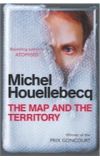
13 Oct 2011 08:44:11
Ever the deadpan comedian, Michel Houellebecq includes in the acknowledgments of the British edition of his new novel, a brief but perfectly straight thank-you to Wikipedia. Following the publication of The Map and the Territory in France last year, he was somewhat half-heartedly accused of plagiarising the information website, co-opting material on houseflies, a French town and a hunting activist. At the time – which was before the novel had won the Prix Goncourt – Houellebecq was rather persuasively dismissive about the allegations, retorting that his detractors understood very little about either literature or his writing methods.It's possible that his publishers entreated – or even commanded – him to mention his debt of gratitude. But Houellebecq, as both his writing and his infrequent forays into public life suggest, doesn't seem like someone who takes much notice of what people tell him to do. Thank goodness. His fifth novel is a wonderfully strange and subversive enterprise, in which a semi-satirical examination of the art world gives way to a gory police procedural, realistic fictional characters mingle with utterly improbable figures who are in fact taken from real life, the author himself makes a low-key entrance and a thoroughly dramatic exit, and subjects under discussion range from the changing nature of the French countryside to the possibility of accurate artistic representations of art and the probability of writing a compelling thriller about radiators.Shortly after the novel opens, its protagonist, an artist called Jed Martin, explains to his elderly father that he plans to ask the celebrated Michel Houellebecq to write the catalogue for his forthcoming exhibition. Although he didn't expect him to have heard of Houellebecq, his father remarks that he has come across his work in the library of his nursing home and advances this opinion: "He's a good author, it seems to me. He's pleasant to read, and he has quite an accurate view of society."Even allowing for the unavoidable vagaries of translation, "pleasant" is not a word that even his greatest admirers would apply to the reading experience Houellebecq offers; rather, one has the sensation of trying to follow a complex but intriguing game while in possession of about half of the rules. In this novel, for example, we are invited, in studiedly detached prose, to contemplate Jed's career, from its earliest beginnings – a youthful project to systematically photograph the world's manufactured objects, from suspension files to handguns to forks – through a period in which he manipulates Michelin maps to the painting phase in which he first encounters Houellebecq. Throughout these apparently discrete passages, Jed's overriding concern is "to give an objective description of the world"; discussions about the extent to which this is possible form the basis of his association with the writer.Novelists who place themselves in their work rarely come out of the endeavour unscathed; the tricksiness of the device is usually either immediately deadening or insufficiently imagined. But in The Map and the Territory, Houellebecq – repeatedly introduced as "the author of Atomised" – is a terrific fictional character. An amalgam of the information and hearsay that we have about him ("It was public knowledge that Houellebecq was a loner with strong misanthropic tendencies") and a vehicle for fragmentary and provocative pronouncements about literature ("I think I've more or less finished with the world as narration – the world of novels and films, the world of music as well. I'm now only interested in the world as juxtaposition – that of poetry and painting"), his existence has the reader dancing around the blurry lines between facts and fiction. And he is also fantastically comic: drunken, irreverent, depressed and inconstant. When they first meet, he lectures Jed about the importance of renouncing pork products out of respect for the intelligence of pigs; some time later, surrounded by packets of chorizo and mortadella and pâté de campagne, he admits despairingly: "I've completely relapsed into charcuterie.""Houellebecq" is destined to encounter problems rather greater than a weakness for salami, and it's best not to give them away here. Jed, meanwhile, is also experiencing difficulties: his series of paintings about professions – the most celebrated of which is entitled Bill Gates and Steve Jobs Discussing the Future of Information Technology: The Conversation at Palo Alto – have made him both wildly rich and enormously acclaimed, but he has a propensity for suddenly abandoning successful work. When a double portrait of artists Jeff Koons and Damien Hirst founders – "He was making a truly shit painting" – he knows he is done, despite the critics' confidence that he has achieved nothing less than an artistic history of the post-industrialised world.The Map and the Territory is a meditation on the relationship between art and the world it seeks to depict, but it is much more besides. Peppered with references to, and appearances by, figures from French cultural life – egregious literary critics, showy television presenters and, most notably, the novelist Frédéric Beigbeder – it anatomises France's preoccupation with its past and its traditions. It deftly skewers the current obsession with the notion of "terroir" – the link between land and identity – by projecting forwards to an imagined future in which wealthy Chinese immigrants make the French countryside more "authentic" than it has ever been through their excessive respect for local customs.

